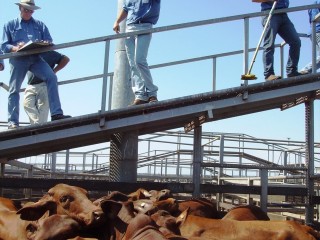 It is a simple comparison that speaks volumes about the impact that forced drought turnoffs and lower cattle prices have had on producer profitability this year.
It is a simple comparison that speaks volumes about the impact that forced drought turnoffs and lower cattle prices have had on producer profitability this year.
Recent throughput data released by the board of the Roma Saleyards, Australia’s largest cattle selling facility, graphically illustrates a broader trend of increased cattle sales for less overall income for many producers this year.
The figures show that from January 1 to October 31 this year, the Roma Saleyards sold 387,639 cattle for a total value of $178m.
For the same period of 2012, the centre sold 279,950 cattle for an overall value of $188m.
In effect, despite selling 98,689 more cattle this year, the total value of all cattle sold is $10 million lower than last year.
Breaking the numbers down to average returns per head, producers have gone from receiving an average price of $674 per head across all categories last year to just $452 per head this year.
At those prices producers would be struggling to cover production costs. Many have also been forced to sell into ‘next year’s’ cattle and income at current unprofitable prices because of drought.
While the data does not detail average weights, this year’s Roma yardings would have included far higher percentages of lighter cattle than last year due to drought, affecting the average price per head.
The figures show that this year’s yardings have also included greater numbers of female cattle as well, which would further impact on the average weight of cattle yarded this year.
The number of heifers sold has surged from 87,972 last year to 133,482 this year (+ 45,510), while the number of cows increased from 45,784 head to 54,229 head (+ 8445). Steer sales increased from 128,627 head to 164,878 (+36,251).
NLRS figures bear out flagging restocker demand
Looking more broadly beyond Roma, MLA NLRS throughput data for five major saleyards in southern Queensland and northern New South Wales highlights the extent to which drier conditions have taken restocker buyers out of play this year.
In the wet year of 2011, all major saleyards throughout the region recorded massive throughputs (see table below).
| CENTRE | 2011 | 2012 | 2013 |
|---|---|---|---|
| Dalby | 392,281 | 195,127 | 193,080 |
| Dubbo | 280,185 | 126,896 | 147,192 |
| Dubbo Store | 54,256 | 54,250 | 59,633 |
| Gunnedah | 209,573 | 82,538 | 73,982 |
| Roma Prime | 143,784 | 60,424 | 53,320 |
| Roma Store | 442,629 | 215,170 | 324,161 |
| Tamworth | 124,435 | 56,593 | 54,294 |
MLA chief economist Tim McRae attributes the high volumes of that year to the amount of trading that occurred, which saw many cattle appear more than once in the same year as they were bought and sold between restockers.
“If we go through those wet years we’re seeing a lot of cattle twice, going back out and coming back in, but I don’t think that is the case this year, the big hit has been in restocker and feeder demand which just hasn’t been there.
In 2011 a lot of the cattle being traded were within killable weight ranges, however processors struggled to compete with producers who were flush with grass to secure them.
This year has seen a complete turnaround, with drought subduing restocker activity and a larger percentage of cattle selling from yards straight to meatworks, despite being of lighter weight.
This has been borne out in average carcase weights, which are down by 10kg this year, despite the fact there have been more cattle on feed.
